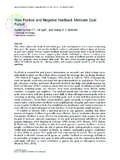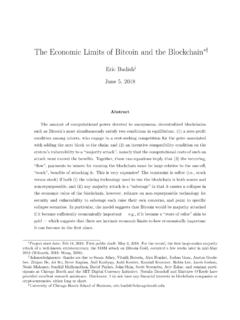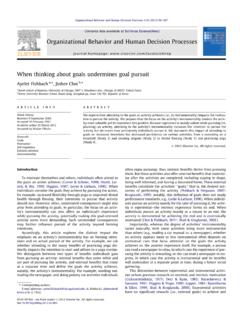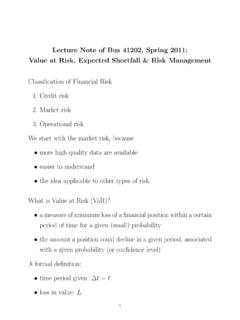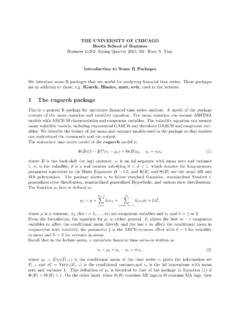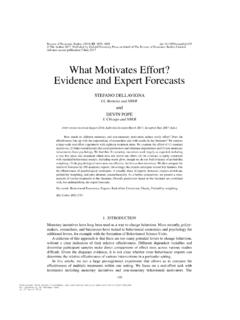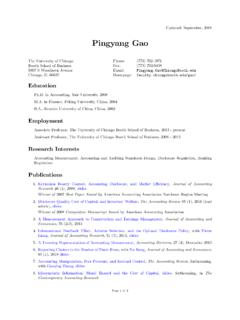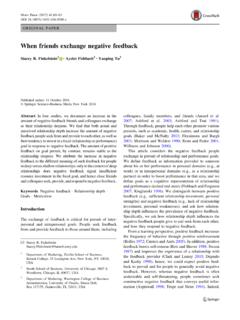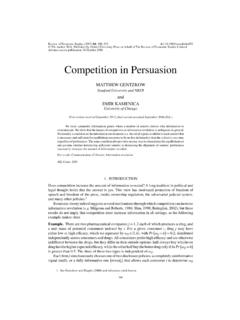Transcription of Split or Steal - Booth School of Business
1 Split or Steal ? Cooperative Behavior When the Stakes Are Large Martijn J. van den Assem Erasmus School of Economics, Erasmus University Rotterdam Dennie van Dolder Erasmus School of Economics/Tinbergen Institute, Erasmus University Rotterdam Richard H. Thaler Booth School of Business , University of Chicago Published in Management Science, January 2012 (58:1), 2 20. Abstract: We examine cooperative behavior when large sums of money are at stake, using data from the TV game show Golden Balls . At the end of each episode, contestants play a variant on the classic Prisoner's Dilemma for large and widely ranging stakes averaging over $20,000. Cooperation is surprisingly high for amounts that would normally be considered consequential but look tiny in their current context, what we call a big peanuts phenomenon. Utilizing the prior interaction among contestants, we find evidence that people have reciprocal preferences.
2 Surprisingly, there is little support for conditional cooperation in our sample. That is, players do not seem to be more likely to cooperate if their opponent might be expected to cooperate. Further, we replicate earlier findings that males are less cooperative than females, but this gender effect reverses for older contestants because men become increasingly cooperative as their age increases. JEL: C72, C93, D03. Version: September 2011 (first draft: April 2010). Keywords: natural experiment, game show, prisoner's dilemma, cooperation, cooperative behavior, social behavior, social preferences, reciprocity, reciprocal behavior, context effects, anchoring Postal address for manuscript correspondence: Erasmus University of Rotterdam, Box 1738, 3000 DR, Rotterdam, the Netherlands. E: T: +31104081329, F: +31104089165.
3 We are grateful to Guido Baltussen, Han Bleichrodt, Uri Gneezy and the anonymous reviewers for their many constructive and valuable comments. We thank Endemol UK and in particular Tara Ali and Tom Blakeson for providing us with information and recordings of Golden Balls , and Shirley Kremer, Thomas Meijer and Sanne van Bemmel for their skillful research assistance. The paper benefited from discussions with seminar participants at the Erasmus University of Rotterdam and Tilburg University, and with participants of the Decision & Uncertainty Workshop 2010 at HEC Paris, BDRM 2010 Pittsburgh, SABE 2010 San Diego, and SPUDM 2011 Kingston upon Thames. We gratefully acknowledge support from the Erasmus Research Institute of Management, the Netherlands Organisation for Scientific Research (NWO), and the Tinbergen Institute.
4 Electronic copy available at: Cooperation is vital for the functioning of society, and the organizations and communities that form its fabric. Not surprisingly, cooperative behavior is the focus of many studies across a wide range of scientific disciplines, including psychology (Dawes, 1980; Dawes and Messick, 2000), sociology (Marwell and Ames, 1979, 1980; Raub and Snijders, 1997), economics (Ledyard, 1995; Fehr and G chter, 2000a; Fischbacher and G chter, 2010), political science (Ostrom, Walker and Gardner, 1992) and biology (Gardner and West, 2004; West, Griffin and Gardner, 2007). The key question in this literature is why humans cooperate even in situations in which doing so is not in line with their material self-interest. While cooperation is ubiquitous in social life and an important topic for all kinds of economic interaction, field data rarely allow for a clean discrimination among competing theories.
5 Because carefully designed laboratory experiments do allow for such rigorous comparisons, laboratory experiments have provided numerous important insights into cooperative behavior, and the resulting rich literature forms the basis of most of our knowledge on human cooperation. Still, laboratory settings inevitably have limitations that some argue may hinder the generalization of findings to situations beyond the context of the lab (Levitt and List, 2007, 2008). Subjects are often volunteering students who thus constitute a non-random sample of the population at large. Also, they generally have less familiarity with decision tasks in the laboratory than with those in everyday life, no opportunity to seek advice from friends or experts, and they know that their behavior is examined in detail. From an economic perspective, another obvious drawback to lab studies is that the financial stakes employed tend to be relatively small.
6 Even those experiments that utilize relatively large payoffs do not involve amounts in excess of a few hundred dollars ( , Hoffman, McCabe and Smith, 1996a;. List and Cherry, 2000; Carpenter, Verhoogen and Burks, 2005), giving rise to the question to what extent findings will generalize to situations of significant economic importance. One solution is to perform experiments in low-income countries, where small nominal amounts carry a larger value. In the domain of social interaction, such experiments are, for example, employed by Slonim and Roth (1998), Cameron (1999), Fehr, Fischbacher and Tougareva (2002), Munier and Zaharia (2002), Johansson-Stenman, Mahmud and Martinsson (2005), and Kocher, Martinsson and Visser (2008). While this might appear an ideal approach, it has its own drawbacks. Culture, for example, has been shown to play an important role in social interaction (Henrich et al.)
7 , 2001, 2004; Herrmann, Th ni and G chter, 2008), making it difficult to generalize findings from low-income And while 1. Interestingly, though not generally acknowledged, this argument at the same time questions the universal applicability of the many findings from higher-income countries, including ours. We refer to Henrich, Heine and Norenzayan (2010) for a discussion on this issue. [2]. Electronic copy available at: the stakes in these experiments are larger than commonly employed, they still rarely exceed a few months' wages. In the current paper, we study cooperative behavior using another source of data, namely the behavior of contestants on the British TV game show Golden Balls . Although the game show setting is an unusual environment, it has the benefit of employing large and varying stakes. Furthermore, game shows are markedly different from laboratory experiments in terms of participant selection, scrutiny, and familiarity of participants with the decision task.
8 Combined with the strict and well- defined rules, game shows can therefore provide unique opportunities to investigate the robustness of existing laboratory findings. Because game shows are often competitive in nature and ask contestants to make risky or strategic choices, is it not surprising that they have mostly been used to study decision making under risk ( , Gertner, 1993; Metrick, 1995; Beetsma and Schotman, 2001; Post et al., 2008) or strategic reasoning ( , Bennett and Hickman, 1993; Berk, Hughson and Vandezande, 1996; Tenorio and Cason, 2002). More recently, however, game shows have also been used to study social interaction, in particular discrimination (Levitt, 2004; Antonovics, Arcidiacono and Walsh, 2005) and cooperative behavior (List, 2004, 2006; Belot, Bhaskar and van de Ven, 2010a; Oberholzer-Gee, Waldfogel and White, 2010).
9 The current paper is in the latter category. In the final stage of Golden Balls , contestants make a choice on whether or not to cooperate in a variant of the famous Prisoner's Dilemma. In particular, the two final contestants independently have to decide whether they want to Split or Steal the jackpot. If both contestants choose Split , they share the jackpot equally. If one chooses Split and the other chooses Steal , the one who steals takes the jackpot and the other gets nothing. If they both Steal , both go home empty-handed. On average, the jackpot is over $20,000. The variation is large: from a few dollars to about $175,000. If we assume that each player only cares about maximizing her immediate financial payoff, the choice problem in Golden Balls can be labeled as a weak form of the Prisoner's Where in the classic form of the Prisoner's Dilemma defecting strictly dominates cooperating, here defecting only weakly dominates cooperating: choosing Steal always does at least as well, and sometimes better than choosing Split .
10 Of course, contestants may consider other factors aside from their own monetary payoff when deciding which choice to make. Much experimental research suggests that people have social preferences in the sense that the payoffs to others enter their utility functions. For discussions, see, for example, Fehr and G chter (1998, 2000b), Fehr and Schmidt (1999), Bolton 2. Rapoport (1988) introduced this terminology. For the sake of brevity, we will simply use the term Prisoner's Dilemma to refer to the game studied here. [3]. and Ockenfels (2000), Charness and Rabin (2002), Camerer (2003), Fehr and Gintis (2007), and Cooper and Kagel (2009). The fact that the show is aired on TV of course creates another set of rather special circumstances that could affect our results, although there is little existing theory to suggest what the effect of a large TV audience would be.
